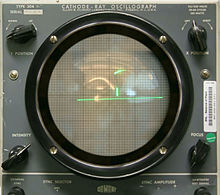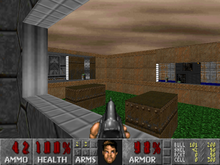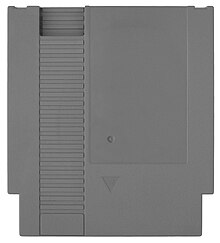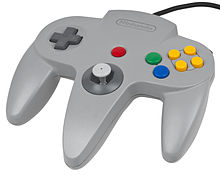Early Video Games
Six-button Genesis/Mega Drive controller that was released later
Nintendo 64 controller
A video game or computer game is an electronic game that involves interaction with a user interface or input device (such as a joystick, controller, keyboard, or motion sensing device) to generate visual feedback from a display device, most commonly shown in a video format on a television set, computer monitor, flat-panel display or touchscreen on handheld devices, or a virtual reality headset. Most modern video games are audiovisual, with audio complement delivered through speakers or headphones, and sometimes also with other types of sensory feedback (e.g., haptic technology that provides tactile sensations), and some video games also allow microphone and webcam inputs for in-game chatting and livestreaming.
Video games are typically categorized according to their hardware platform, which traditionally includes arcade video games, console games, and computer (PC) games; the latter also encompasses LAN games, online games, and browser games. More recently, the video game industry has expanded onto mobile gaming through mobile devices (such as smartphones and tablet computers), virtual and augmented reality systems, and remote cloud gaming. Video games are also classified into a wide range of genres based on their style of gameplay and target audience.
The first video game prototypes in the 1950s and 1960s were simple extensions of electronic games using video-like output from large, room-sized mainframe computers. The first consumer video game was the arcade video game Computer Space in 1971. In 1972 came the iconic hit game Pong and the first home console, the Magnavox Odyssey. The industry grew quickly during the “golden age” of arcade video games from the late 1970s to early 1980s but suffered from the crash of the North American video game market in 1983 due to loss of publishing control and saturation of the market. Following the crash, the industry matured, was dominated by Japanese companies such as Nintendo, Sega, and Sony, and established practices and methods around the development and distribution of video games to prevent a similar crash in the future, many of which continue to be followed. In the 2000s, the core industry centered on “AAA” games, leaving little room for riskier experimental games. Coupled with the availability of the Internet and digital distribution, this gave room for independent video game development (or “indie games“) to gain prominence into the 2010s. Since then, the commercial importance of the video game industry has been increasing. The emerging Asian markets and proliferation of smartphone games in particular are altering player demographics towards casual gaming and increasing monetization by incorporating games as a service.
Today, video game development requires numerous interdisciplinary skills, vision, teamwork, and liaisons between different parties, including developers, publishers, distributors, retailers, hardware manufacturers, and other marketers, to successfully bring a game to its consumers. As of 2020, the global video game market had estimated annual revenues of US$159 billion across hardware, software, and services, which is three times the size of the global music industry and four times that of the film industry in 2019, making it a formidable heavyweight across the modern entertainment industry. The video game market is also a major influence behind the electronics industry, where personal computer component, console, and peripheral sales, as well as consumer demands for better game performance, have been powerful driving factors for hardware design and innovation.
Origins

Early video games use interactive electronic devices with various display formats. The earliest example is from 1947—a “cathode-ray tube amusement device” was filed for a patent on 25 January 1947, by Thomas T. Goldsmith Jr. and Estle Ray Mann, and issued on 14 December 1948, as U.S. Patent 2455992. Inspired by radar display technology, it consists of an analog device allowing a user to control the parabolic arc of a dot on the screen to simulate a missile being fired at targets, which are paper drawings fixed to the screen. Other early examples include Christopher Strachey‘s draughts game, the Nimrod computer at the 1951 Festival of Britain; OXO, a tic-tac-toe computer game by Alexander S. Douglas for the EDSAC in 1952; Tennis for Two, an electronic interactive game engineered by William Higinbotham in 1958; and Spacewar!, written by Massachusetts Institute of Technology students Martin Graetz, Steve Russell, and Wayne Wiitanen’s on a DEC PDP-1 computer in 1961. Each game has different means of display: NIMROD has a panel of lights to play the game of Nim, OXO has a graphical display to play tic-tac-toe, Tennis for Two has an oscilloscope to display a side view of a tennis court, and Spacewar! has the DEC PDP-1’s vector display to have two spaceships battle each other.
These preliminary inventions paved the way for the origins of video games today. Ralph H. Baer, while working at Sanders Associates in 1966, devised a control system to play a rudimentary game of table tennis on a television screen. With the company’s approval, Baer built the prototype “Brown Box”. Sanders patented Baer’s inventions and licensed them to Magnavox, which commercialized it as the first home video game console, the Magnavox Odyssey, released in 1972. Separately, Nolan Bushnell and Ted Dabney, inspired by seeing Spacewar! running at Stanford University, devised a similar version running in a smaller coin-operated arcade cabinet using a less expensive computer. This was released as Computer Space, the first arcade video game, in 1971. Bushnell and Dabney went on to form Atari, Inc., and with Allan Alcorn, created their second arcade game in 1972, the hit ping pong-style Pong, which was directly inspired by the table tennis game on the Odyssey. Sanders and Magnavox sued Atari for infringement of Baer’s patents, but Atari settled out of court, paying for perpetual rights to the patents. Following their agreement, Atari made a home version of Pong, which was released by Christmas 1975. The success of the Odyssey and Pong, both as an arcade game and home machine, launched the video game industry. Both Baer and Bushnell have been titled “Father of Video Games” for their contributions.
Development

Video game development and authorship, much like any other form of entertainment, is frequently a cross-disciplinary field. Video game developers, as employees within this industry are commonly referred, primarily include programmers and graphic designers. Over the years this has expanded to include almost every type of skill that one might see prevalent in the creation of any movie or television program, including sound designers, musicians, and other technicians; as well as skills that are specific to video games, such as the game designer. All of these are managed by producers.
In the early days of the industry, it was more common for a single person to manage all of the roles needed to create a video game. As platforms have become more complex and powerful in the type of material they can present, larger teams have been needed to generate all of the art, programming, cinematography, and more. This is not to say that the age of the “one-man shop” is gone, as this is still sometimes found in the casual gaming and handheld markets, where smaller games are prevalent due to technical limitations such as limited RAM or lack of dedicated 3D graphics rendering capabilities on the target platform (e.g., some PDAs).
Video games are programmed like any other piece of computer software. Prior to the mid-1970s, arcade and home consoles were programmed by assembling discrete electro-mechanical components on circuit boards, which limited games to relatively simple logic. By 1975, low-cost microprocessors were available at volume to be used for video game hardware, which allowed game developers to program more detailed games, widening the scope of what was possible. Ongoing improvements in computer hardware technology has expanded what has become possible to create in video games, coupled with convergence of common hardware between console, computer, and arcade platforms to simplify the development process. Today, game developers have a number of commercial and open source tools available for use to make games, often which are across multiple platforms to support portability, or may still opt to create their own for more specialized features and direct control of the game. Today, many games are built around a game engine that handles the bulk of the game’s logic, gameplay, and rendering. These engines can be augmented with specialized engines for specific features, such as a physics engine that simulates the physics of objects in real-time. A variety of middleware exists to help developers to access other features, such as for playback of videos within games, network-oriented code for games that communicate via online services, matchmaking for online games, and similar features. These features can be used from a developers’ programming language of choice, or they may opt to also use game development kits that minimize the amount of direct programming they have to do but can also limit the amount of customization they can add into a game. Like all software, video games usually undergo quality testing before release to assure there are no bugs or glitches in the product, though frequently developers will release patches and updates.
With the growth of the size of development teams in the industry, the problem of cost has increased. Development studios need the best talent, while publishers reduce costs to maintain profitability on their investment. Typically, a video game console development team ranges from 5 to 50 people, and some exceed 100. In May 2009, Assassin’s Creed II was reported to have a development staff of 450. The growth of team size combined with greater pressure to get completed projects into the market to begin recouping production costs has led to a greater occurrence of missed deadlines, rushed games and the release of unfinished products.
While amateur and hobbyist game programming had existed since the late 1970s with the introduction of home computers, a newer trend since the mid-2000s is indie game development. Indie games are made by small teams outside any direct publisher control, their games being smaller in scope than those from the larger “AAA” game studios, and are often experiment in gameplay and art style. Indie game development are aided by larger availability of digital distribution, including the newer mobile gaming marker, and readily-available and low-cost development tools for these platforms.
Terminology
The term “video game” was developed to distinguish this class of electronic games that were played on some type of video display rather than on a teletype printer, audio speaker or similar device. This also distinguished from many handheld electronic games like Merlin which commonly used LED lights for indicators but did not use these in combination for imaging purposes.
“Computer game” may also be used as a descriptor, as all these types of games essentially require the use of a computer processor, and in some cases, it is used interchangeably with “video game”. Particularly in the United Kingdom and Western Europe, this is common due to the historic relevance of domestically produced microcomputers. Other terms used include digital game, for example by the Australian Bureau of Statistics. However, the term “computer game” can also be used to more specifically refer to games played primarily on personal computers or other type of flexible hardware systems (also known as a PC game), as a way distinguish them from console games, arcade games or mobile games. Other terms such as “television game” or “telegame” had been used in the 1970s and early 1980s, particularly for the home gaming consoles that rely on connection to a television set. In Japan, where consoles like the Odyssey were first imported and then made within the country by the large television manufacturers such as Toshiba and Sharp Corporation, such games are known as “TV games”, or TV geemu or terebi geemu. “Electronic game” may also be used to refer to video games, but this also incorporates devices like early handheld electronic games that lack any video output. and the term “TV game” is still commonly used into the 21st century.
The first appearance of the term “video game” emerged around 1973. The Oxford English Dictionary cited a 10 November 1973 BusinessWeek article as the first printed use of the term. Though Bushnell believed the term came from a vending magazine review of Computer Space in 1971, a review of the major vending magazines Vending Times and Cashbox showed that the term came much earlier, appearing first around March 1973 in these magazines in mass usage including by the arcade game manufacturers. As analyzed by video game historian Keith Smith, the sudden appearance suggested that the term had been proposed and readily adopted by those involved. This appeared to trace to Ed Adlum, who ran Cashbox‘s coin-operated section until 1972 and then later founded RePlay Magazine, covering the coin-op amusement field, in 1975. In a September 1982 issue of RePlay, Adlum is credited with first naming these games as “video games”: “RePlay’s Eddie Adlum worked at ‘Cash Box’ when ‘TV games’ first came out. The personalities in those days were Bushnell, his sales manager Pat Karns and a handful of other ‘TV game’ manufacturers like Henry Leyser and the McEwan brothers. It seemed awkward to call their products ‘TV games’, so borrowing a word from Billboard‘s description of movie jukeboxes, Adlum started to refer to this new breed of amusement machine as ‘video games.’ The phrase stuck.”[citation needed] Adlum explained in 1985 that up until the early 1970s, amusement arcades typically had non-video arcade games such as pinball machines and electro-mechanical games. With the arrival of video games in arcades during the early 1970s, there was initially some confusion in the arcade industry over what term should be used to describe the new games. He “wrestled with descriptions of this type of game,” alternating between “TV game” and “television game” but “finally woke up one day” and said, “what the hell… video game!”
For many years, the traveling Videotopia exhibit served as the closest representation of such a vital resource. In addition to collecting home video game consoles, the Electronics Conservancy organization set out to locate and restore 400 antique arcade cabinets after realizing that the majority of these games had been destroyed and feared the loss of their historical significance. Video games have significantly began to be seen in the real-world as a purpose to present history in a way of understanding the methodology and terms that are being compared. Researchers have looked at how historical representations affect how the public perceives the past, and digital humanists encourage historians to use video games as primary materials. Video games, considering their past and age, have over time progressed as what a video game really means. Whether played through a monitor, TV, or a hand-held device, there are many ways that video games are being displayed for users to enjoy. People have drawn comparisons between flow-state-engaged video gamers and pupils in conventional school settings. In traditional, teacher-led classrooms, students have little say in what they learn, are passive consumers of the information selected by teachers, are required to follow the pace and skill level of the group (group teaching), and receive brief, imprecise, normative feedback on their work. Video games, as they continue to develop into better graphic definition and genre’s, create new terminology when something unknown tends to become known. Yearly, consoles are being created to compete against other brands with similar functioning features that tends to lead the consumer into which they’d like to purchase. Now, companies have moved towards games only the specific console can play to grasp the consumer into purchasing their product compared to when video games first began, there was little to no variety. In 1989, a console war begun with Nintendo, one of the biggest in gaming was up against target, Sega with their brand new Master System which, failed to compete, allowing the Nintendo Emulator System to be one of the most consumed product in the world. More technology continued to be created, as the computer began to be used in people’s houses for more than just office and daily use. Games began being implemented into computers and have progressively grown since then with coded robots to play against you. Early games like tic-tac-toe, solitaire, and Tennis for Two were great ways to bring new gaming to another system rather than one specifically meant for gaming.
Definition
While many games readily fall into a clear, well-understood definition of video games, new genres and innovations in game development have raised the question of what are the essential factors of a video game that separate the medium from other forms of entertainment.
The introduction of interactive films in the 1980s with games like Dragon’s Lair, featured games with full motion video played off a form of media but only limited user interaction. This had required a means to distinguish these games from more traditional board games that happen to also use external media, such as the Clue VCR Mystery Game which required players to watch VCR clips between turns. To distinguish between these two, video games are considered to require some interactivity that affects the visual display.
Most video games tend to feature some type of victory or winning conditions, such as a scoring mechanism or a final boss fight. The introduction of walking simulators (adventure games that allow for exploration but lack any objectives) like Gone Home, and empathy games (video games that tend to focus on emotion) like That Dragon, Cancer brought the idea of games that did not have any such type of winning condition and raising the question of whether these were actually games. These are still commonly justified as video games as they provide a game world that the player can interact with by some means.
The lack of any industry definition for a video game by 2021 was an issue during the case Epic Games v. Apple which dealt with video games offered on Apple’s iOS App Store. Among concerns raised were games like Fortnite Creative and Roblox which created metaverses of interactive experiences, and whether the larger game and the individual experiences themselves were games or not in relation to fees that Apple charged for the App Store. Judge Yvonne Gonzalez Rogers, recognizing that there was yet an industry standard definition for a video game, established for her ruling that “At a bare minimum, videogames appear to require some level of interactivity or involvement between the player and the medium” compared to passive entertainment like film, music, and television, and “videogames are also generally graphically rendered or animated, as opposed to being recorded live or via motion capture as in films or television”. Rogers still concluded that what is a video game “appears highly eclectic and diverse”.
Video Game Terminology

The gameplay experience varies radically between video games, but many common elements exist. Most games will launch into a title screen and give the player a chance to review options such as the number of players before starting a game. Most games are divided into levels which the player must work the avatar through, scoring points, collecting power-ups to boost the avatar’s innate attributes, all while either using special attacks to defeat enemies or moves to avoid them. This information is relayed to the player through a type of on-screen user interface such as a heads-up display atop the rendering of the game itself. Taking damage will deplete their avatar’s health, and if that falls to zero or if the avatar otherwise falls into an impossible-to-escape location, the player will lose one of their lives. Should they lose all their lives without gaining an extra life or “1-UP”, then the player will reach the “game over” screen. Many levels as well as the game’s finale end with a type of boss character the player must defeat to continue on. In some games, intermediate points between levels will offer save points where the player can create a saved game on storage media to restart the game should they lose all their lives or need to stop the game and restart at a later time. These also may be in the form of a passage that can be written down and reentered at the title screen.
Product flaws include software bugs which can manifest as glitches which may be exploited by the player; this is often the foundation of speedrunning a video game. These bugs, along with cheat codes, Easter eggs, and other hidden secrets that were intentionally added to the game can also be exploited. On some consoles, cheat cartridges allow players to execute these cheat codes, and user-developed trainers allow similar bypassing for computer software games. Both of which might make the game easier, give the player additional power-ups, or change the appearance of the game.
Other Game Platforms and Technologies

To distinguish from electronic games, a video game is generally considered to require a platform, the hardware which contains computing elements, to process player interaction from some type of input device and displays the results to a video output display.[36]
Platform

Video games require a platform, a specific combination of electronic components or computer hardware and associated software, to operate. The term system is also commonly used. Games are typically designed to be played on one or a limited number of platforms, and exclusivity to a platform is used as a competitive edge in the video game market. However, games may be developed for alternative platforms than intended, which are described as ports or conversions. These also may be remasters – where most of the original game’s source code is reused and art assets, models, and game levels are updated for modern systems – and remakes, where in addition to asset improvements, significant reworking of the original game and possibly from scratch is performed.
The list below is not exhaustive and excludes other electronic devices capable of playing video games such as PDAs and graphing calculators.
- PC games
- PC games involve a player interacting with a personal computer (PC) connected to a video monitor. Personal computers are not dedicated game platforms, so there may be differences running the same game on different hardware. Also, the openness allows some features to developers like reduced software cost,[41] increased flexibility, increased innovation, emulation, creation of modifications or mods, open hosting for online gaming (in which a person plays a video game with people who are in a different household) and others. A gaming computer is a PC or laptop intended specifically for gaming, typically using high-performance, high-cost components. In additional to personal computer gaming, there also exist games that work on mainframe computers and other similarly shared systems, with users logging in remotely to use the computer.
- Home console
-

The PlayStation 2 is the best-selling video game console, with over 155 million units sold. A console game is played on a home console, a specialized electronic device that connects to a common television set or composite video monitor. Home consoles are specifically designed to play games using a dedicated hardware environment, giving developers a concrete hardware target for development and assurances of what features will be available, simplifying development compared to PC game development. Usually consoles only run games developed for it, or games from other platform made by the same company, but never games developed by its direct competitor, even if the same game is available on different platforms. It often comes with a specific game controller. Major console platforms include Xbox, PlayStation and Nintendo.
- Handheld console
- A handheld game console is a small, self-contained electronic device that is portable and can be held in a user’s hands. It features the console, a small screen, speakers and buttons, joystick or other game controllers in a single unit. Like consoles, handhelds are dedicated platforms, and share almost the same characteristics. Handheld hardware usually is less powerful than PC or console hardware. Some handheld games from the late 1970s and early 1980s could only play one game. In the 1990s and 2000s, a number of handheld games used cartridges, which enabled them to be used to play many different games. The handheld console has waned in the 2010s as mobile device gaming has become a more dominant factor.
- Arcade video game
-

A police-themed arcade game in which players use a light gun An arcade video game generally refers to a game played on an even more specialized type of electronic device that is typically designed to play only one game and is encased in a special, large coin-operated cabinet which has one built-in console, controllers (joystick, buttons, etc.), a CRT screen, and audio amplifier and speakers. Arcade games often have brightly painted logos and images relating to the theme of the game. While most arcade games are housed in a vertical cabinet, which the user typically stands in front of to play, some arcade games use a tabletop approach, in which the display screen is housed in a table-style cabinet with a see-through table top. With table-top games, the users typically sit to play. In the 1990s and 2000s, some arcade games offered players a choice of multiple games. In the 1980s, video arcades were businesses in which game players could use a number of arcade video games. In the 2010s, there are far fewer video arcades, but some movie theaters and family entertainment centers still have them.
- Browser game
- A browser game takes advantages of standardizations of technologies for the functionality of web browsers across multiple devices providing a cross-platform environment. These games may be identified based on the website that they appear, such as with Miniclip games. Others are named based on the programming platform used to develop them, such as Java and Flash games.
- Mobile game
- With the introduction of smartphones and tablet computers standardized on the iOS and Android operating systems, mobile gaming has become a significant platform. These games may use unique features of mobile devices that are not necessary present on other platforms, such as accelerometers, global positing information and camera devices to support augmented reality gameplay.
- Cloud gaming
- Cloud gaming requires a minimal hardware device, such as a basic computer, console, laptop, mobile phone or even a dedicated hardware device connected to a display with good Internet connectivity that connects to hardware systems by the cloud gaming provider. The game is computed and rendered on the remote hardware, using a number of predictive methods to reduce the network latency between player input and output on their display device. For example, the Xbox Cloud Gaming and PlayStation Now platforms use dedicated custom server blade hardware in cloud computing centers.
- Virtual reality
-

Players using the PlayStation VR headsets in 2017 Virtual reality (VR) games generally require players to use a special head-mounted unit that provides stereoscopic screens and motion tracking to immerse a player within virtual environment that responds to their head movements. Some VR systems include control units for the player’s hands as to provide a direct way to interact with the virtual world. VR systems generally require a separate computer, console, or other processing device that couples with the head-mounted unit.
- Emulation
- An emulator enables games from a console or otherwise different system to be run in a type of virtual machine on a modern system, simulating the hardware of the original and allows old games to be played. While emulators themselves have been found to be legal in United States case law, the act of obtaining the game software that one does not already own may violate copyrights. However, there are some official releases of emulated software from game manufacturers, such as Nintendo with its Virtual Console or Nintendo Switch Online offerings.
- Backward compatibility
- Backward compatibility is similar in nature to emulation in that older games can be played on newer platforms, but typically directly though hardware and build-in software within the platform. For example, the PlayStation 2 is capable of playing original PlayStation games simply by inserting the original game media into the newer console, while Nintendo’s Wii could play GameCube titles as well in the same manner.
Game media

Early arcade games, home consoles, and handheld games were dedicated hardware units with the game’s logic built into the electronic componentry of the hardware. Since then, most video game platforms are considered programmable, having means to read and play multiple games distributed on different types of media or formats. Physical formats include ROM cartridges, magnetic storage including magnetic-tape data storage and floppy discs, optical media formats including CD-ROM and DVDs, and flash memory cards. Furthermore digital distribution over the Internet or other communication methods as well as cloud gaming alleviate the need for any physical media. In some cases, the media serves as the direct read-only memory for the game, or it may be the form of installation media that is used to write the main assets to the player’s platform’s local storage for faster loading periods and later updates.
Games can be extended with new content and software patches through either expansion packs which are typically available as physical media, or as downloadable content nominally available via digital distribution. These can be offered freely or can be used to monetize a game following its initial release. Several games offer players the ability to create user-generated content to share with others to play. Other games, mostly those on personal computers, can be extended with user-created modifications or mods that alter or add onto the game; these often are unofficial and were developed by players from reverse engineering of the game, but other games provide official support for modding the game.
Input device

Video game can use several types of input devices to translate human actions to a game. Most common are the use of game controllers like gamepads and joysticks for most consoles, and as accessories for personal computer systems along keyboard and mouse controls. Common controls on the most recent controllers include face buttons, shoulder triggers, analog sticks, and directional pads (“d-pads”). Consoles typically include standard controllers which are shipped or bundled with the console itself, while peripheral controllers are available as a separate purchase from the console manufacturer or third-party vendors. Similar control sets are built into handheld consoles and onto arcade cabinets. Newer technology improvements have incorporated additional technology into the controller or the game platform, such as touchscreens and motion detection sensors that give more options for how the player interacts with the game. Specialized controllers may be used for certain genres of games, including racing wheels, light guns and dance pads. Digital cameras and motion detection can capture movements of the player as input into the game, which can, in some cases, effectively eliminate the control, and on other systems such as virtual reality, are used to enhance immersion into the game.
Display and output

By definition, all video games are intended to output graphics to an external video display, such as cathode-ray tube televisions, newer liquid-crystal display (LCD) televisions and built-in screens, projectors or computer monitors, depending on the type of platform the game is played on. Features such as color depth, refresh rate, frame rate, and screen resolution are a combination of the limitations of the game platform and display device and the program efficiency of the game itself. The game’s output can range from fixed displays using LED or LCD elements, text-based games, two-dimensional and three-dimensional graphics, and augmented reality displays.
The game’s graphics are often accompanied by sound produced by internal speakers on the game platform or external speakers attached to the platform, as directed by the game’s programming. This often will include sound effects tied to the player’s actions to provide audio feedback, as well as background music for the game.
Some platforms support additional feedback mechanics to the player that a game can take advantage of. This is most commonly haptic technology built into the game controller, such as causing the controller to shake in the player’s hands to simulate a shaking earthquake occurring in game.
Other Genres
A video game, like most other forms of media, may be categorized into genres. However, unlike film or television which use visual or narrative elements, video games are generally categorized into genres based on their gameplay interaction, since this is the primary means which one interacts with a video game. The narrative setting does not impact gameplay; a shooter game is still a shooter game, regardless of whether it takes place in a fantasy world or in outer space. An exception is the horror game genre, used for games that are based on narrative elements of horror fiction, the supernatural, and psychological horror. Genre names are normally self-describing in terms of the type of gameplay, such as action game, role playing game, or shoot ’em up, though some genres have derivations from influential works that have defined that genre, such as roguelikes from Rogue,[51] Grand Theft Auto clones from Grand Theft Auto III, and battle royale games from the film Battle Royale. The names may shift over time as players, developers and the media come up with new terms; for example, first-person shooters were originally called “Doom clones” based on the 1993 game. A hierarchy of game genres exist, with top-level genres like “shooter game” and “action game” that broadly capture the game’s main gameplay style, and several subgenres of specific implementation, such as within the shooter game first-person shooter and third-person shooter. Some cross-genre types also exist that fall until multiple top-level genres such as action-adventure game.
Types
Most video games are intended for entertainment purposes. Different game types include:
- Core games
- Core or hard-core games refer to the typical perception of video games, developed for entertainment purposes. These games typically require a fair amount of time to learn and master, in contrast to casual games, and thus are most appealing to gamers rather than a broader audience. Most of the AAA video game industry is based around the delivery of core games.
- Casual games
- In contrast to core games, casual games are designed for ease of accessibility, simple to understand gameplay and quick to grasp rule sets, and aimed at mass market audience. They frequently support the ability to jump in and out of play on demand, such as during commuting or lunch breaks. Numerous browser and mobile games fall into the casual game area, and casual games often are from genres with low intensity game elements such as match three, hidden object, time management, and puzzle games. Causal games frequently use social-network game mechanics, where players can enlist the help of friends on their social media networks for extra turns or moves each day. Popular casual games include Tetris and Candy Crush Saga. More recent, starting in the late 2010s, are hyper-casual games which use even more simplistic rules for short but infinitely replayable games, such as Flappy Bird.
- Educational games
- Education software has been used in homes and classrooms to help teach children and students, and video games have been similarly adapted for these reasons, all designed to provide a form of interactivity and entertainment tied to game design elements. There are a variety of differences in their designs and how they educate the user. These are broadly split between edutainment games that tend to focus on the entertainment value and rote learning but are unlikely to engage in critical thinking, and educational video games that are geared towards problem solving through motivation and positive reinforcement while downplaying the entertainment value. Examples of educational games include The Oregon Trail and the Carmen Sandiego series. Further, games not initially developed for educational purposes have found their way into the classroom after release, such as that feature open worlds or virtual sandboxes like Minecraft, or offer critical thinking skills through puzzle video games like SpaceChem.
- Serious games
-

Microsoft Flight Simulator is an example of a simulation game. Further extending from educational games, serious games are those where the entertainment factor may be augmented, overshadowed, or even eliminated by other purposes for the game. Game design is used to reinforce the non-entertainment purpose of the game, such as using video game technology for the game’s interactive world, or gamification for reinforcement training. Educational games are a form of serious games, but other types of games include fitness games that incorporate significant physical exercise to help keep the player fit (such as Wii Fit), simulator games that resemble fight simulators to pilot aircraft (such as Microsoft Flight Simulator), advergames that are built around the advertising of a product (such as Pepsiman), and newsgames aimed at conveying a specific advocacy message (such as NarcoGuerra).
- Art games
- Although video games have been considered an art form on their own, games may be developed to try to purposely communicate a story or message, using the medium as a work of art. These art or arthouse games are designed to generate emotion and empathy from the player by challenging societal norms and offering critique through the interactivity of the video game medium. They may not have any type of win condition and are designed to let the player explore through the game world and scenarios. Most art games are indie games in nature, designed based on personal experiences or stories through a single developer or small team. Examples of art games include Passage, Flower, and That Dragon, Cancer.
Source: wikipedia.org














